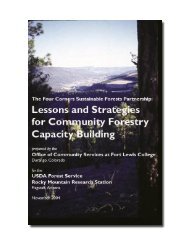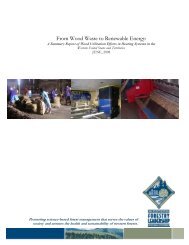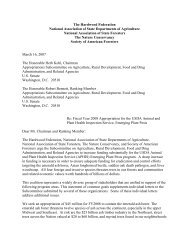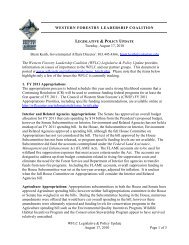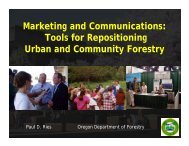Emission Controls for Small Wood-Fired Boilers - Western Forestry ...
Emission Controls for Small Wood-Fired Boilers - Western Forestry ...
Emission Controls for Small Wood-Fired Boilers - Western Forestry ...
You also want an ePaper? Increase the reach of your titles
YUMPU automatically turns print PDFs into web optimized ePapers that Google loves.
• Some projects have condensers to remove the moisture from the flue gases simultaneously<br />
recovering some additional thermal energy.<br />
• The average ash content is about 2‐5% of the biomass and reflects burning lower quality<br />
biomass (in some cases). The ash streams are collected separately and utilized where<br />
appropriate. The ash from the multi‐cyclone and the combustion chamber of the boiler may be<br />
used as fertilizer in farm operations. The ash from ESP (fine ash) is land filled, as it may contain<br />
heavy metals.<br />
• The capital cost of a typical ESP <strong>for</strong> a new power plant of 5 to 10 MW capacity range was<br />
typically about 12‐14% of the cost of the project. This percent may be more <strong>for</strong> smaller capacity<br />
plants producing only heat.<br />
• The quality of woodchips is not considered to be very critical. This is likely attributable to the<br />
widespread use of ESPs.<br />
7.0 CAPITAL COSTS OF EMISSION CONTROLS FOR PARTICULATE<br />
MATTER<br />
Capital and operating costs were estimated with quotes from and personal communication with<br />
equipment vendors as well as the equations and methods presented in the “EPA Cost Control Manual.” 1<br />
In<strong>for</strong>mation used to generate costs is detailed in the appendix. In addition to the size of the biomass<br />
combustor, there are a number of other factors which cause variability in the capital costs. Here is a<br />
selected list of factors affecting price variability:<br />
• Change in the price of steel. This change had a significant affect on the price of the Core<br />
Separator and other mechanical collectors.<br />
• Foreign exchange rates. For equipment purchased overseas, specifically Europe, the cost is<br />
significantly affected by the exchange rate, which now increases price <strong>for</strong> US installations. The<br />
two high efficiency multicyclones featured in this report were purchased from a European<br />
vendor.<br />
• Pollution control device design. Capital costs are also affected by the pollution control<br />
equipment design. For example, the price of electrostatic precipitators is sensitive to the size of<br />
the particle collection plates. Collection efficiency is related to collection plate size; there<strong>for</strong>e,<br />
projects requiring relatively high collection efficiency will result in larger collection plates and a<br />
more expenive electrostatic precipitator.<br />
• Fuel characteristics. As mentioned systems having variable firing rates burning wet fuels are<br />
susceptible to filter clogging if a baghouse is installed. As a result, baghouses are now typically<br />
designed with additional components which mitigate the problem, but significantly increase<br />
price.<br />
• Space requirements. The amount of horizontal and vertical space required <strong>for</strong> a given control<br />
can affect the installation cost. For examples, baghouses can require more space than<br />
electrostatic precipitators. The additional space required can increase the footprint and/or<br />
height of the building housing the equipment, thereby increasing construction costs.<br />
• Ancillary equipment. For example, baghouses require more ancillary equipment, such as<br />
insulated ductwork and a mechanical collector (to reduce fire risk), than an ESP.<br />
1<br />
EPA Cost Control Manual, Sixth Edition. U.S EPA report #EPA/452/B‐02‐001. January, 2002. Available at:<br />
http://www.epa.gov/ttn/catc/dir1/c_allchs.pdf.<br />
Resource Systems Group, Inc.<br />
<strong>Emission</strong> Control Technologies <strong>for</strong> <strong>Small</strong> <strong>Wood</strong>‐<strong>Fired</strong> <strong>Boilers</strong><br />
6 May 2010 Page 20



